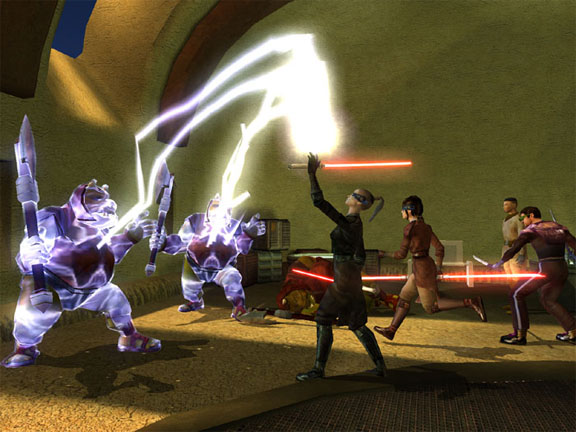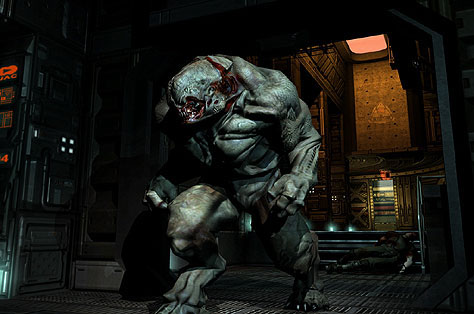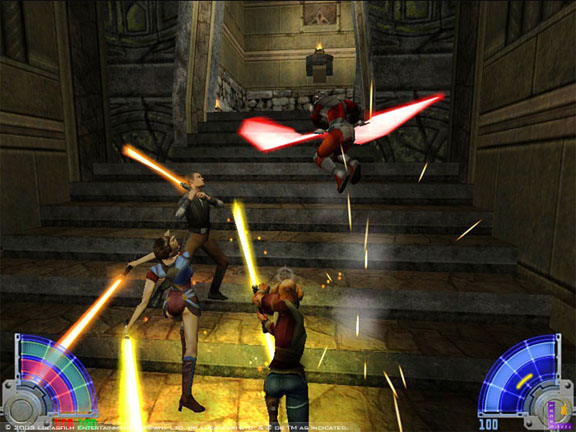
This is a screen from 2003's Star Wars: Knights of the Old Republic, developed by Bioware for the XBox and PC, published by LucasArts, and fondly identified by its fans simply as "Kotor." In terms of its overall excellence -- game design, story, character development, graphics/animation, sound, voice acting, musical score, and even quality control -- Kotor truly deserved the many "Game of the Year" awards bestowed by the game press, and was one of the very best games I have ever played.
With such high expectations for 2004's Kotor 2: The Sith Lords, the sequel is at once blessed -- it has an instant fan base and a guaranteed commercial success -- and cursed. Equipped with the same dated graphic engine and game design as the original, Sith Lords would always be judged against the standards of its groundbreaking predecessor. After many late-night sessions and repeated play-through's, I am pleased to report that Sith Lords' exquisite storytelling and intriguing roster of characters more than compensate for its technical limitations.
Virtual Journeys
For me, the great satisfaction of playing video games is
not unlike that of a long trip abroad: becoming completely immersed in an
environment that excites the senses, rouses the emotions and stimulates the
mind.
This naturally leads me to two game genres to which I am
wholeheartedly dedicated. My first love is the venerable role-playing game
(RPG), one of the earliest electronic gaming formats, which intricately weaves
character development, tactical combat and epic storytelling into one
unforgettable experience. The other is the visceral, technology-driven and
controversial first-person shooter (FPS), where my monitor screen becomes the
eye that stares starkly into another world.
Role-Playing Games. I've been playing RPGs for as long as there have been RPGs for the home computer. Alongside my Apple II, I diligently mapped the dungeons of Wizardry and The Bard's Tale onto reams of graph paper, while making notes of every conversation and magic reagent recipe found in the first four installments of the Ultima series.
Fast-forward many years into the recent past, and I rediscover the joy of the narrative in almost every game within the "Forgotten Realms" multiverse. It is a wondrous smorgasbord of Hellenic, Nordic, Semitic and Indian myths, as well as artful appropriation of JRR Tolkien's magnificent creations by such noted fantasy novelists as R. A. Salvatore and Ed Greenwood. Every element is elegantly structured in the deep, dynamic gameplay of the Dungeons and Dragons tradition, and profoundly influenced by the literary movement of magical realism, which infuses the fantastic and the otherworldly with contemporary angst and prosaic pathos.
A cherished conceit amongst the vast RPG library is the ability to guide one's characters along the path of good or evil, thus reaching alternate plot outcomes and prompting multiple replays. In the past, the player would select the moral alignment of his/her character at the very beginning of the game, so that the character would benefit (or suffer) from taking actions that are best (or least) suited for that chosen alignment. Recent RPGs such as Fable and the two Star Wars: Knights of the Old Republic ("Kotor") titles now have characters starting at an ethical tabula rasa, allowing them gradually to grow into heroes or villains via the consequences of the decisions the player makes throughout the game. Nowhere else is this more compelling than the two Kotor games, where the eternal struggle between the Light and Dark sides of the Force has inspired some of the most thought-provoking scenarios I have ever encountered.
No one issued the edict that RPGs must be scored with haunting, majestic symphonic and choral compositions, but that has ever been the norm since these games are first burnt onto CD-ROMs, much to the delight of this lifelong classical-music listener. Here, many RPG players will think immediately of the works of Nobuo Uematsu, whose poignant leitmotifs throughout the entire Final Fantasy series are universally endearing. Another prolific favorite is Jeremy Soule, whose rich, melodic scores for Baldur's Gate, Icewind Dale, Neverwinter Nights, Morrowind, Dungeon Siege and Star Wars: Knights of the Old Republic are just as memorable.
Here is a list of RPGs I like (and I've played a LOT of them), listed roughly in the order that I played them over the past two decades, using various hardware at my disposal. I loved Baldur's Gate II, Shadows of Amn so much that I even posted, in serial installments, a fictional narrative of my entire experience on the Interplay community forum. With the exception of Fable, which is given a "Mature" rating by the Entertainment Software Rating Board (ESRB) for its cheeky invocation of marital sex (straight or gay) and the use of the four-letter word for excrement, all games released here since the rating system's inception in 1994 are rated "Teen." ("Mature" ratings are not recommended for gamers under 17 of age; the suggested age limit for "Teen" rated games is thirteen.)
|
The Tasks of Heracles (Apple II, publisher not noted) | |
|
Wizardry: Proving Grounds of the Mad Overlord (Apple II and Apple Macintosh Plus, Sir-Tech) | |
|
The Bard's Tale (Apple II, Electronic Arts) | |
|
Ultima I, II, III, and IV (Apple II, Origin/Spectrum Holobyte/Sierra Online) | |
|
The Bard's Tale II (Apple Macintosh Plus, Electronic Arts) | |
|
Might and Magic IV (Apple Macintosh Plus, New World Computing/3DO) | |
|
Forgotten Realms: The Azure Bonds (Apple Macintosh Si, SSI "Gold Box" edition) | |
|
Forgotten Realms: The Pools of Darkness (Apple Macintosh Si, SSI "Gold Box" edition) | |
|
Ultima IX: Ascension (Pentium PC, Sierra Online) | |
|
Diablo (Pentium PC, Blizzard) | |
|
Might and Magic V: Mandate of Heaven (Pentium 2 PC, New World Computing/3DO) | |
|
Forgotten Realms: Baldur's Gate, Tales of the Sword Coast (Pentium 3 PC, Bioware-Black Isle/Interplay) | |
|
Forgotten Realms: Icewind Dale I and II, Heart of Winter (Pentium 3 PC, Black Isle/Interplay) | |
|
Forgotten Realms: Planescape Torment (Pentium 3 PC, Bioware-Black Isle/Interplay) | |
|
Final Fantasy VII (PlayStation, SquareSoft) | |
|
Forgotten Realms: Baldur's Gate II, Shadows of Amn and The Throne of Bhaal (Pentium 4 PC, Bioware/Interplay) | |
|
Final Fantasy VIII (PlayStation, Square Enix) | |
|
Diablo II (Pentium 4 PC, Blizzard) | |
|
Forgotten Realms: Neverwinter Nights (Pentium 4 PC, Bioware/Atari) | |
|
Elder Scrolls: Morrowind (Xbox, Bethesda) | |
|
Final Fantasy X (PlayStation 2, Square Enix) | |
|
Star Wars: Knights of the Old Republic (Xbox, Bioware/LucasArts) | |
|
Forgotten Realms: NWN Shadows of Undrentide, The Hordes of the Underdark (Pentium 4 PC, Bioware/Atari) | |
|
Final Fantasy X-II (Playstation 2, Square Enix) | |
|
Fable (Xbox, Lionhead Studios/Big Blue Box/Microsoft Game Studios) | |
Star Wars, Knights of the Old Republic II: The Sith Lords (Xbox, Obsidian/LucasArts) |

Welcome to Mars...and Hell. This is Id Software's Doom 3, sporting the most advanced graphic engine of 2004 for the PC. Like many other enthusiasts, I've extensively upgraded my hardware partly in anticipation of this technological milestone. Beneath the state-of-the-art graphics, this is a rather straightforward presentation of science-fiction-cum-gothic-horror, which I find far less disturbing than the realistic depictions of modern warfare or street crime that are prevalent amongst today's first-person shooters.
First-Person Shooters. Let's get my reservations out of the way first:
I do not generally enjoy realistic war games or, as recent trends would have it,
simulations of violent street crimes. They remind me too much of the troubling
headlines I read every morning, which reward heinous wrongdoers with the
glamorous notoriety or "street creds" they so covet. These perverse
caricatures of reality also suggest that, rather than learning from our
collective mistakes in history as warmongers and criminals, we can sublimate all
shortcomings of humanity by restaging our conflicts in a sanitized, artificial
setting, where we can then reclaim our victories with a base premise –
that of nothing else but an Uzi in each hand, loaded and blazing.
Not all gaming technophiles appreciate the violence, gore
and vulgarity associated with shooters, but none would ever deny their visceral
power. The FPS is where game developers truly push the envelope, both in terms
of content and technology. Nowhere else are so many 3D polygons, texture maps
and multi-channeled sounds processed with such ferocious sophistication to
recreate the physics – and the cognitive psychology – of a frighteningly
realistic world. We have but one company to thank for all this since the very
beginning: Id Software, led by the genius programmer that is John Carmack.

As much as I enjoyed replaying Kotor and Kotor 2, there is one other Star Wars game from 2003 that I've been playing even more often. This is Jedi Academy, the fourth and most polished of the first-person/third person hybrid games published by LucasArts, available for the PC, Mac and Xbox. This title, like its immediate predecessor Jedi Outcast, is developed by Raven, utilizing the Quake 3 graphic engine initially produced by Id Software. Both Kotor and Jedi Academy also showcased the talent of actress Jennifer Hale, who voiced the ingénue academy student Jaden Kor and Bastila Shan, the sultry yet vulnerable Jedi prodigy central to Kotor's story.
With all that said, the Star Wars franchise appears to be
the least guilt-laden of my FPS pleasures. After all, who wouldn't like to be a
Jedi, wielding a lightsaber (or two!) and commanding Force powers in a distant galaxy
where good and evil are so clearly and beautifully defined?
Everyone who played the Jedi Knight games knows that,
to engage in melee combat with a lightsaber, one must leave the first-person
perspective and see the player character in the iconic third-person view. With
this feature, the series are reunited with the mainstream heritage of
action-adventure games that began with the platform-jumping Mario, thus allowing
Jedi's Kyle Katarn, Mara Jade and Jaden Kor to join such luminaries as Tomb
Raider's Lara Croft, Metal Gear Solid's Solid Snake, Ninja Gaiden's Ryu
Hayabusa, the Prince of Persia, and Splinter Cell's Sam Fisher. (Other notable characters gifted with this
versatility include Hitman's Agent 47, Garret the Thief, and Metroid Prime's
Samus, although in her third-person view Samus is rolled into a human pinball.)
Listed here are my personal recommendations amongst the first-person shooters,
again listed roughly in the order of play. Halo and Jedi Academy are two games
where I continue to find new nuances, despite their dated graphics; Halo
2, released in time for Holiday '04 for happy Xbox owners, is a most worthy
sequel that enhances the original, but does not supplant it. Far Cry presents the most natural environment and the cleverest
artificial intelligence I've seen to date. With Doom 3, FPS pioneer Id Software
will have the most advanced (and hardware-taxing) graphic engine for many months
to come.
Released at long last for Holiday '04 is a title that provides the most convincing immersion in a game world, where every droplet of rain over dirty water is utterly believable, real-time facial animation borders on pre-rendered verisimilitude, and nearly every environmental object is endowed with realistic mass and volume, to be improvised as a puzzle solution or a projectile weapon at a creative player's whim. Here's my hat off to quite possibly the Game of the Year for 2004: Valve's Half-Life 2, itself the immediate successor (though six year in the making) to the masterpiece that was the original Half-Life.
Expectedly, the gory gunfire violence in every FTS game here released since 1994 is the reason for its "Mature" rating by the ESRB, with the exception of the Star Wars titles, which are rated "Teen."
|
Castle Wolfenstein (60386 PC, Id Software) | |
|
Doom (60386 PC, Id Software) | |
|
Star Wars: Dark Forces (Macintosh II cx, LucasArts) | |
|
Marathon 2: Durandal (Macintosh II cx, Bungie) | |
|
Quake (Pentium PC, Id Software) | |
|
Star Wars: Jedi Knight, Mysteries of the Sith (Pentium 2 PC, LucasArts) | |
|
Turok, Dinosaur Hunter (Nintendo 64, Acclaim) | |
|
Unreal, Unreal Tournament (Pentium 3 PC, Epic/Ubisoft) | |
|
Quake 2 (Pentium 3 PC, Id Software) | |
|
Hexen (Pentium 3 PC, Raven/Activision) | |
|
Thief: the Dark Project (Pentium 3 PC, Eidos) | |
Half-Life (Pentium 3 PC, Valve/Sierra Online) | |
|
No One Lives Forever (Pentium 3 PC, Sierra-Monolith/Fox Interactive) | |
|
Soldier of Fortune (Pentium 3 PC, Raven/Activision) | |
|
Star Wars: Jedi Outcast (Pentium 4 PC, Raven/LucasArts) | |
|
Max Payne (Pentium 4 PC, Remedy/Rockstar Games) | |
|
Halo (Xbox, Bungie/Microsoft) | |
|
Star Wars: Jedi Academy (Pentium 4 PC, Raven/LucasArts) | |
|
Far Cry (Pentium 4 PC, Crytek/Ubisoft) | |
|
Doom 3 (Pentium 4 PC, Id Software) | |
Halo 2 (Xbox, Bungie/Microsoft Game Studios) | |
Half-Life 2 (Pentium 4 PC, Valve/Vivendi Universal) |
| Back to top |
